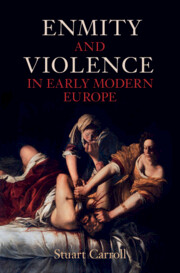Book contents
- Enmity and Violence in Early Modern Europe
- Enmity and Violence in Early Modern Europe
- Copyright page
- Dedication
- Epigraph
- Contents
- Figures
- Maps
- Tables
- Acknowledgements
- Introduction
- Italy
- Germany
- France
- England
- Comparisons
- 12 The Experience of Enmity
- 13 Enmity and Sacred Space
- 14 Living with the Enemy
- Conclusion
- Select Bibliography
- Index
Conclusion
from Comparisons
Published online by Cambridge University Press: 12 March 2023
- Enmity and Violence in Early Modern Europe
- Enmity and Violence in Early Modern Europe
- Copyright page
- Dedication
- Epigraph
- Contents
- Figures
- Maps
- Tables
- Acknowledgements
- Introduction
- Italy
- Germany
- France
- England
- Comparisons
- 12 The Experience of Enmity
- 13 Enmity and Sacred Space
- 14 Living with the Enemy
- Conclusion
- Select Bibliography
- Index
Summary
The conclusion summarises the main findings of the book. The erosion of medieval hierarchies and systems of mediation made competition for material resources and status rivalries more intense after 1500. Enmity is rooted in a sense of injustice and there was a growth in distrust between those who gained from and those who lost out to the burgeoning of state power. The law shaped enmity and mediated violence, but it did not repress them altogether. Enmity was a major threat to public order because its scale and intensity was related to the struggle for social and political capital. Most significant in generating the rise in elite violence was social change and the development of a caste code in which retaliation was seen as socially acceptable and politically necessary. The social elite were the most avid consumers of the law, and they used the courts alongside violence to uphold their honour and enforce their rights: rising rates of litigation in the sixteenth century were part of the same process of contention as rising rates of homicide. And just as violence declined in the eighteenth century, so did rates of litigation. The law promoted arbitration and reconciliation at every stage of the process. But the desire of the parties to fulfil their obligations and make use of the myriad institutions of mediation was dependent on social and political circumstance.
- Type
- Chapter
- Information
- Enmity and Violence in Early Modern Europe , pp. 460 - 467Publisher: Cambridge University PressPrint publication year: 2023



